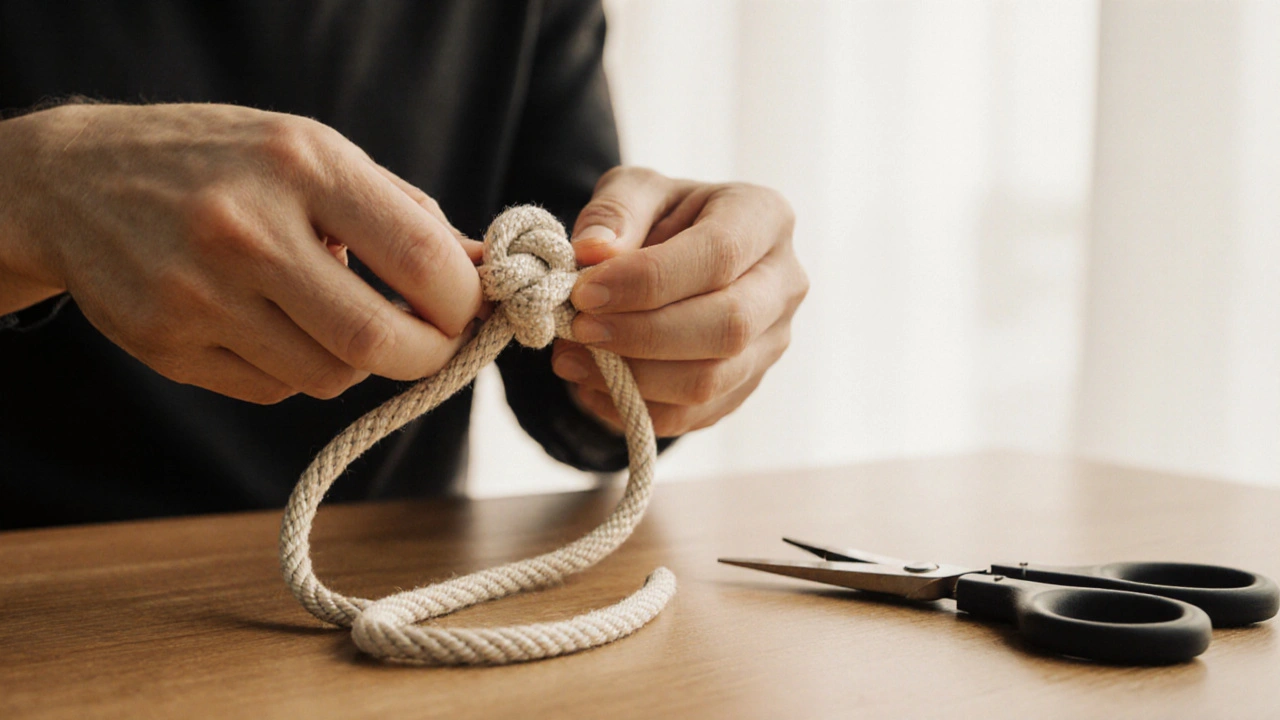Ever caught yourself wondering why bondage keeps showing up in movies, books, and even conversations among friends? Truth is, it’s a lot more common—and a lot less scary—than people think. Bondage, at its core, is just the practice of restraining someone for fun, usually in a sexual way, but not always. It's about trust, excitement, and trying something outside the everyday routine.
If you’re new to all this, you might be picturing something extreme, but in reality, most people start off gentle. A soft scarf, handcuffs you can buy online, or even using your own hands can do the trick. The goal isn't pain—it's about the feelings that come with giving up or taking control for a little while. That’s the hook: the rush of trust and the buzz of adrenaline. And yes, there are things you really do need to know about safety, so you can have fun without worry.
- What is Bondage and Why Does it Captivate?
- Bondage Benefits: Pleasure, Trust, and Excitement
- Types of Bondage: From Basics to Beyond
- How to Practice Bondage Safely
- First-Timer Tips and Common Questions
What is Bondage and Why Does it Captivate?
Bondage is the act of physically restraining someone using things like ropes, cuffs, belts, or even household items. For a lot of people, it’s a central part of bondage and BDSM play, but you don’t need to be part of a secret club to give it a try. Most folks start simple and keep things consensual and safe—think using a tie around the wrists, or a scarf as a blindfold. There’s nothing mystical or dangerous about it when you follow some basic rules.
So, what’s the big appeal? Why does something as basic as tying someone up grab people’s interest? It’s a mix of psychology and physical sensation. Feeling restrained can heighten other senses, ramp up excitement, and help people let go of day-to-day stress. And for the person doing the restraining, it’s about exploring trust and control in a way that feels playful and intimate. In everyday conversations, trust keeps coming up. People mention how it’s not just about control—it’s about really trusting your partner and feeling vulnerable in a good way.
If you’re into numbers, a 2022 survey by the Kinsey Institute found that nearly 47% of adults have tried some form of light bondage, like using handcuffs or ribbons. It’s not fringe or just for experts—lots of folks are curious, and a big chunk decide to take things further after a positive first experience.
| Bondage Fact | Source/Year |
|---|---|
| 47% of adults have tried light bondage | Kinsey Institute, 2022 |
| BDSM-related Google searches grew by 15% in three years | Google Trends, 2021 |
| Most popular beginner tool: Silk scarf | Sexual Health Research, 2023 |
What keeps people coming back? Variety, for one. There are endless ways to participate, so you can find what works for you—no need to follow a script. For some, it’s about the thrill and adrenaline; for others, it’s simply about shaking up the bedroom routine. You don’t need to go wild, and you definitely don’t need to spend a fortune on gear. You just need curiosity, a bit of open-mindedness, and a partner you trust.
Bondage Benefits: Pleasure, Trust, and Excitement
Why are so many people drawn to bondage? It’s not just about the physical side—it goes way deeper. Bondage brings a mix of sensations and feelings you don’t really get from "vanilla" sex or even other types of kink. Let’s break down why people keep coming back for more.
Pleasure: For lots of folks, being tied up or restrained puts the senses into overdrive. Losing control ramps up excitement and makes every touch feel more intense. Some techniques, like sensory play or teasing, are known to boost arousal and even help some people reach stronger orgasms. In a 2022 survey published by Sex Research Social Policy, over 40% of people who tried bondage said it made sex more thrilling and fun.
Trust: Here’s something most outsiders don’t realize—bondage is built on trust. If you’re the one being tied, you need to feel safe. If you’re the one tying, you’re taking on someone else’s well-being. This level of trust builds connection and intimacy, often making couples feel closer. The shared experience makes it easier to open up and communicate (especially about what feels good, and what doesn’t).
Excitement: When you add in the unexpected, a little suspense, or just the newness of trying something out of your comfort zone, the excitement goes up. Many couples use bondage to shake up their routine. A national poll in 2023 found that 35% of adults said trying something "taboo"—like bondage—helped them rekindle a spark in their relationship. For some, it’s about feeling a rush of adrenaline; for others, it’s about the feeling of power or surrender.
To get a sense of what people value most in bondage, check out this snapshot from a 2024 online survey of 1,000 participants who practice bondage:
| Top Reported Benefit | Percentage (%) |
|---|---|
| Heightened Pleasure | 46 |
| Trust & Intimacy | 37 |
| Adds Excitement | 33 |
| Improved Communication | 28 |
The bottom line? Bondage isn’t just about knots and rope—it’s about connection, pleasure, and a fresh take on intimacy. Whether you want to spice up your love life or just try something new, these benefits are why so many folks add a little restraint to the mix.

Types of Bondage: From Basics to Beyond
Bondage covers a whole range of styles, from easy stuff you can try at home to skills you pick up with practice. If you’re testing the waters, you definitely don’t have to jump to anything complicated. Here’s how it usually breaks down:
- Basic Restraints: These are the classic starter moves—think handcuffs, blindfolds, rope, silk scarves, or even zip ties if you’re in a pinch (but watch out for skin!). You can buy premade kits online or just use what you have at home. Most beginners start by tying wrists or ankles to the bedpost. The main thing is that it should always be easy to undo quickly if needed.
- Roleplay Ties: Adding in a scenario, like playing cops and robbers or doctor and patient, makes simple restraints even more exciting. Props help, but the real fun usually comes from swapping roles and making up the rules.
- Shibari (Japanese Rope Art): This is a popular form of bondage, and it’s all about patterns, knots, and making the body look cool. A lot of people get really into learning the art side of it—not just the tying but the aesthetic. There are classes for this (online and in-person), and plenty of YouTube tutorials, but never leave someone tied up alone.
- Spread-Eagle or X-Position Ties: This type uses cuffs, ropes, or straps to keep arms and legs apart. It can be done on a bed or against special furniture made just for bondage. You feel pretty exposed, which is half the thrill for many.
- Bondage Furniture: If you’ve seen movies with swings or those big wooden X-shapes (called St. Andrew’s Crosses), you know what this is. You don’t need fancy gear to start, but folks who enjoy bondage often collect these as things get serious.
Just for fun, check out this table to see how people get started in bondage, based on a 2023 online survey with over 2,000 participants:
| Bondage Type | Percent Who Tried It First |
|---|---|
| Basic Restraints (Handcuffs or Scarves) | 62% |
| Roleplay Ties | 18% |
| Shibari Rope Bondage | 12% |
| Spread-Eagle Ties | 7% |
| Furniture or Advanced Gear | 1% |
So if you're wondering where to start, it’s smart to go basic and work your way up. Try things at your own pace. Always focus on safety, comfort, and what actually excites both you and your partner. There’s no rush and no rule saying you need to go all-in on day one.
How to Practice Bondage Safely
Before you even lay a finger on a rope or a pair of cuffs, safety has to be your number one priority. This isn’t just about avoiding injuries—it’s about making sure everyone feels secure and respected. Communicating up front takes the edge off nerves and stops mix-ups before they start.
Bondage beginners and veterans alike should always talk about boundaries and use a safe word. A safe word is just a code word that anyone can say to pause or stop everything immediately—think simple stuff like “red” for stop or “yellow” for slow down. No one’s too cool for a safe word. And if you find it awkward? That’s totally normal. It gets easier.
- Use gear designed for bondage, especially when starting out. Things made for restraint are usually softer and less likely to cause real harm.
- Avoid tying anything tightly around the neck—that can easily go wrong. Stay away from wrists or ankles if you don’t know what you’re doing, as nerves are easy to pinch there.
- Make sure you can always get out quickly. Safety scissors are essential if you’re using rope. They’re not expensive and can cut through most materials fast if you need to bail out in a hurry.
- Keep checking in, even after tying someone up. Ask if everything feels okay, and watch for numbness, tingling, or changes in color that show blood flow might be cut off.
- Don’t leave the person tied up on their own. Things can change in seconds.
Here's a quick table to show key safety points and what to watch for:
| What To Do | Why It Matters |
|---|---|
| Set a safe word | Makes it easy to pause or stop fast |
| Use bondage-specific equipment | Reduces risk of injury (never use zip ties or hard belts) |
| Keep safety scissors nearby | Quick exit if there’s trouble |
| Check circulation | Prevents numbness, tingling, and injury |
| Never leave anyone tied up alone | Immediate help if needed |
If you keep these basics in mind, you’ll avoid most risks—and both of you will actually have more fun, because you’re not secretly stressing about what could go wrong. Bondage is about trust, after all. Safety is what lets you relax and enjoy the experience for real.

First-Timer Tips and Common Questions
Trying out bondage for the first time? It can feel awkward and exciting all at once, but you’re not alone. Tons of people give it a go every year and come away with nothing but good stories. Here’s what you really need to know to start off right and avoid rookie mistakes.
- Talk Before You Try: Real talk matters. Chat with your partner about what you’re both curious about or nervous about. Don’t assume; ask. This helps make sure everyone’s on the same page and avoids unwanted surprises.
- Pick Simple Gear: No need for fancy ropes or pro-level restraints to begin with. Grab a soft scarf, an old tie, or beginner handcuffs from a trusted shop. The focus should be on comfort and safety, not expensive gadgets.
- Agree on a Safe Word: Safe words aren’t just for movies—they really work. Pick something easy to say, like “red” or “pineapple.” If anyone says the word, everything stops, no questions asked. This keeps things fun and stress-free.
- Keep Safety Scissors Close: Even if you’re sure nothing will go wrong, always have a pair within reach. Stuff can happen quick. Getting stuck isn’t as funny in real life as it sounds in theory.
- Start Slow: You don’t need to choose an intense position or elaborate knots. Just tying hands above the head or at the sides works great. See how it feels before moving on to more complex stuff.
People new to bondage usually have loads of questions, so here are the top ones I hear all the time:
- Is bondage dangerous? It can be if you ignore safety. Stick to basic ties, check circulation (skin should stay pink, not blue or tingly), and have those scissors ready.
- Do I need to be flexible? Nope. Choose positions that feel natural and comfy for both of you. You don’t have to twist into pretzels to enjoy the experience.
- What if I feel weird or embarrassed? Totally normal! Nearly everyone feels a little silly at first. Laugh it off and remind yourself this is supposed to be fun, not stressful.
- Is this for every couple? Not always. Some folks love it, others don’t. There’s no right or wrong—just what works for you.
Best tip? Take it slow, be safe, and don’t be afraid to pause for a minute if something doesn’t feel right. Trust and communication make all the difference when you’re exploring new ground together.









